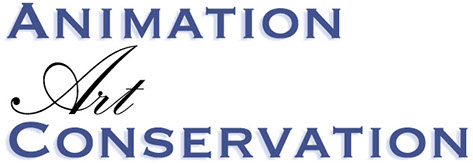
COPYRIGHTS AND RESTRICTIONS AND CONDITIONS OF THIS WEBSITE
The Ethical Method of Repair
The Attention is in the Details
the Lost and FOUND series
RON BARBAGALLO:
ANIMATION ART CONSERVATION
The Ethical Approach to Repair

BEFORE

AFTER
CLICK BELOW TO SEE EXAMPLES OF BEFORE AND AFTER TREATMENTS
• Conservation of the Original Paint Layer
• Conservation and Reattachment of Damaged Paper Elements
• Conservation of Original Disneyland Art Corner Background
• Conservation of Folded Cel Sheet
• Removal of Adhesive Staining
• Removal of Paper from the Reverse Side of an Opaqued Paint Layer
• Removal of Paper and Cellophane Tape from Reverse Side of Courvoisier Backing Board
In all venues that deal with the repair of art objects, the most respected road to repair is the one by which the object's original paint and surface are retained. This way of thinking is well accepted in the fine art world, but it has taken great effort to move animation art from the arena of repainting cels and backgrounds to the actual conservation of the art form, where the original material is repaired instead of replaced.
Objects are of a very specific place and time when they was created. Most of us understand the value of an original object, as most of us, if ever presented with the dilemma, would prefer to have our own flesh and blood hand to a prosthetic one made of metal or plastic. For similar reasons, it is unthinkable that anyone would dare remove the impassioned hand pressed ink of Jefferson’s “Declaration of Independence” or the delicate, if slightly overworked, glazes from Da Vinci’s “Mona Lisa."
I believe in the value of a paint layer that is 60 years old, even if that paint layer might display a few flaws. I also believe that those paint layers hold a value for the collector, because, faded or otherwise, they are a connection to the hands of the inker and opaquer who painted that cel at the studio decades ago. That connection is unique and can be revisited every time you single frame the particular part of the film that corresponds to your art work. Frozen in frame, you find variances within the line work and idiosyncrasies within the old paint layer that developed as it mottled and dried into place.
Because I believe in the original object, I decided years ago to not to pursue a practice which involved the complete restoration of animation art but rather to push the repair of animation art into the realm of actual conservation of the existing paint layers, a practice that involves retaining the original flaked and fallen pieces of paint and reattaching them to the original cel material.
Encouraged by some of my clients, I have applied this same thinking to the repair of painted backgrounds, paper drawings, backing boards, folds in cel sheets and even the repair of Disneyland Art Corner backgrounds. Repairs are done solely by caring for the original materials.